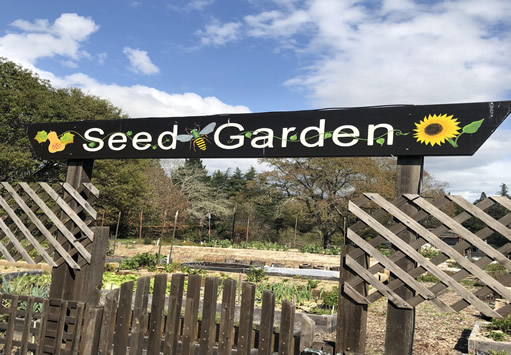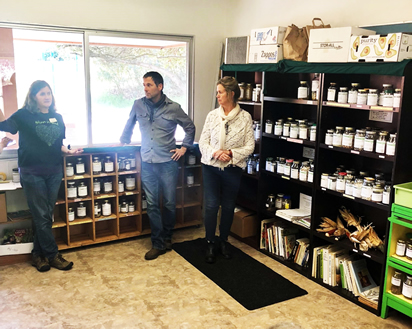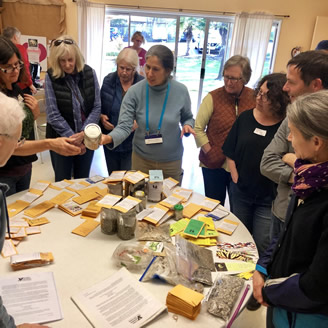Reflections on the California Seed Library Gathering
On Saturday, March 23, the team from Victory Gardens for Peace headed from Mendocino to Sebastopol to participate in the California Seed Library Gathering, hosted by Community Seed Exchange. New to seed saving myself, I didn't know what to expect, but was immediately inspired and energized as we entered a welcoming group full of passion and knowledge. The gathering brought together seed stewards from all around the Bay Area: gardeners and seed savers responsible for establishing and maintaining gardens, seed libraries and seed banks in their communities. The gathering had a very non-hierarchical, collective approach to discussion, something that felt reflective of seed saving itself, in its community-centered foundation and focus. The topics covered included building community through seed saving; the The One Seed One Community Project; accomplishing more with less; seed adaptation; seed saving resources; and what to grow. I was excited to hear from the folks at Community Seed Exchange that after a decade of dedication to the project, their seed saving program and garden was thriving, with much community interest, engagement, and a strong core of committed volunteers to help carry the work forward. This generated hope in our gathering, as it demonstrated the potential of every one of our seed projects to thrive. Perhaps their project's success is reflective of the seed saving movement as a whole--that it is expanding through the growing interest and involvement of the public. We launched into a dialogue on what led to successes in our projects. People spoke to making seed saving accessible and fun, and increasing community interest by hosting events and workshops around seed saving and gardening, such as: seed swaps, seed cleaning workshops, seed packet decorating, educational classes, making seed bombs, community seed planting, cooking food from the garden, and food politics discussions. The One Seed One Community Project is seeing a positive response to their unique approach of uniting the community through focusing on growing a single seed variety at a time and using that as an opportunity to tell the stories and cultural histories of that seed. Another "success" element mentioned was building partnerships with existing organizations and seeking out already available resources. Partnerships represented included churches, master gardeners, libraries, and educational institutions.
While the quantity of seed returned has often been used to measure the success of seed libraries, many people at the gathering felt there was value in people simply taking seed and planting those seeds, whether they are returned or not. Focusing first on planting seeds for food alone is an important step of engagement that should be recognized. While the goal is to have a community full of gardeners and seed savers, acquiring an understanding and valuing the importance of seed saving takes time, and often planting a seed, even with no intention of saving it, is what kickstarts that process. Another big discussion was about seed adaptation, especially in the face of climate change. Climate change presents a tremendous challenge to our food systems and food security, rendering seed saving not just important and interesting, but necessary. By maintaining a strong network of seed savers, we can preserve and maintain biodiversity and crop variety. With this diversity will come resilience: of plants, of our food systems, and of our communities. As one person said in the discussion, "The diversity of the world is cared for by the gardeners." As gardeners and seed savers we can play a critical role in building diverse and resilient food webs, one seed at a time. While this requires an awareness of how plants will/are being impacted by climate change, we must recognize how plants can be our partners in combating climate change through carbon fixing, soil building, and nourishing us – all of which should also be considered in our seed saving and gardening process. Adapting to and minimizing the effects of climate change will require a strong and connected network, socially and environmentally. Luckily, through seed saving, we can accomplish both!
Rebecca Newbum from Richmond Grows Seed Lending Library Saving seeds and growing food for ourselves and our communities provides a tangible, positive and meaningful outlet through which we can address some of the environmental and social challenges of our time on a local level. Many people at the gathering saw the process of saving seeds and growing food as a source of hope, happiness and fulfillment, generating connection, building community, and bridging generations. Seed saving provides the opportunity to honor the knowledge our elders carry, while also honoring the legacy of each seed, and of all the seed stewards and communities that helped that seed to exist today. As seed savers we are privileged to be a part of that story and to continue the legacy. Each one of us can play an important role in this movement, and it starts with just one seed and one community. Seed Saving 101 If you're interested in seed saving but don't know where to start, look at the seed saving tips and resources below!
Below is one example of how to save seed! Peas & Common Beans
Look for a seed library or seed bank near you! Community Seed Network lists just some of the many seed savers and exchanges nationwide. Check out their website to see if there are any seed savers and sharers near you. top | Newsletter Home |Table of Contents| Archive
|





